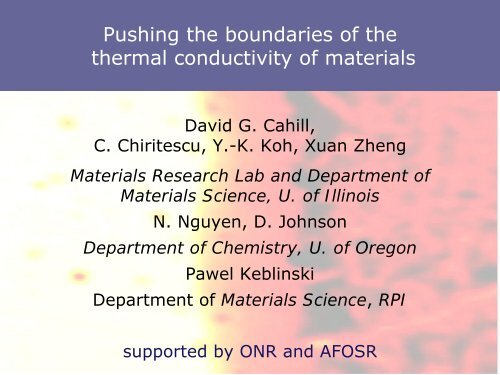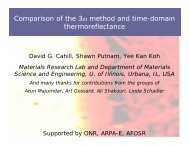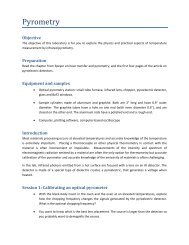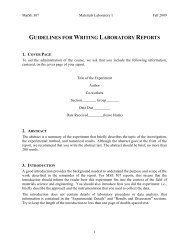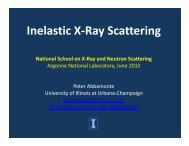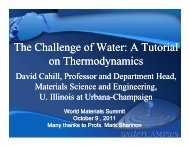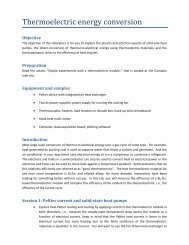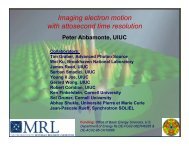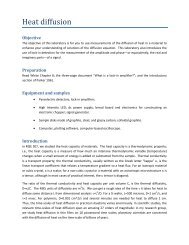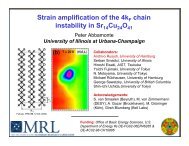Pushing the boundaries of the thermal conductivity of materials
Pushing the boundaries of the thermal conductivity of materials
Pushing the boundaries of the thermal conductivity of materials
You also want an ePaper? Increase the reach of your titles
YUMPU automatically turns print PDFs into web optimized ePapers that Google loves.
<strong>Pushing</strong> <strong>the</strong> <strong>boundaries</strong> <strong>of</strong> <strong>the</strong><br />
<strong>the</strong>rmal <strong>conductivity</strong> <strong>of</strong> <strong>materials</strong><br />
David G. Cahill,<br />
C. Chiritescu, Y.-K. Koh, Xuan Zheng<br />
Materials Research Lab and Department <strong>of</strong><br />
Materials Science, U. <strong>of</strong> Illinois<br />
N. Nguyen, D. Johnson<br />
Department <strong>of</strong> Chemistry, U. <strong>of</strong> Oregon<br />
Pawel Keblinski<br />
Department <strong>of</strong> Materials Science, RPI<br />
supported by ONR and AFOSR
Outline<br />
• Thermal <strong>conductivity</strong> and interface <strong>the</strong>rmal<br />
conductance.<br />
• Advances in time-domain <strong>the</strong>rmoreflectance.<br />
• Amorphous limit to <strong>the</strong> <strong>the</strong>rmal <strong>conductivity</strong> <strong>of</strong><br />
<strong>materials</strong>.<br />
• Ultralow <strong>the</strong>rmal <strong>conductivity</strong>: beating <strong>the</strong><br />
amorphous limit in nanolaminates and disordered<br />
layered crystals.
Interfaces are critical at <strong>the</strong> nanoscale<br />
• Low <strong>the</strong>rmal <strong>conductivity</strong> in<br />
nanostructured <strong>materials</strong><br />
– improved <strong>the</strong>rmoelectric<br />
energy conversion<br />
– improved <strong>the</strong>rmal barriers<br />
• High <strong>the</strong>rmal <strong>conductivity</strong><br />
composites and suspensions<br />
50 nm
Interfaces are critical at <strong>the</strong> nanoscale<br />
• High power density<br />
devices<br />
– solid state lighting<br />
– high speed and<br />
power electronics<br />
– nanoscale sensors<br />
Micrograph <strong>of</strong> tunneling magnetoresistive sensor<br />
for 120 GB drives, M. Kautzky (Seagate)
Thermal <strong>conductivity</strong> and interface <strong>the</strong>rmal conductance<br />
• Thermal <strong>conductivity</strong> Λ is a property <strong>of</strong> <strong>the</strong><br />
continuum<br />
• Thermal conductance (per unit area) G is a<br />
property <strong>of</strong> an interface
Thermal <strong>conductivity</strong> and interface <strong>the</strong>rmal conductance<br />
• Both properties are difficult to understand and<br />
control because <strong>the</strong>y are integral properties.<br />
• For example, simplest case <strong>of</strong> <strong>the</strong>rmal<br />
<strong>conductivity</strong> where resistive scattering<br />
dominates<br />
Λ = 1/3∫ C(ω) v(ω) l(ω) dω<br />
C(ω) = heat capacity <strong>of</strong> phonon mode<br />
v(ω) = group velocity<br />
l(ω) = mean-free-path
Brief introduction to <strong>the</strong>rmoelectric <strong>materials</strong><br />
• Solid-state heat pump; <strong>the</strong>rmal efficiency<br />
governed by <strong>the</strong> “figure <strong>of</strong> merit” ZT<br />
ZT<br />
2<br />
S σT<br />
= Λ<br />
Lon Bell, Science (2008)<br />
S = Seebeck coefficient<br />
σ = electrical <strong>conductivity</strong><br />
Λ = <strong>the</strong>rmal <strong>conductivity</strong>
Brief introduction to <strong>the</strong>rmoelectric <strong>materials</strong><br />
• … or write ZT in a more obviously<br />
dimensionless form…<br />
ZT<br />
Snyder, Caltech,<br />
http://<strong>the</strong>rmoelectrics.caltech.edu<br />
Λ = Λ lattice + Λ electronic<br />
Λ electronic = LσT<br />
2<br />
⎛ ⎞<br />
S<br />
1<br />
= ⎜ ⎟<br />
⎝ L ⎠1<br />
+ Λ / Λ<br />
( )<br />
lattice electronic
Carbon nanotubes<br />
• Evidence for <strong>the</strong> highest <strong>the</strong>rmal <strong>conductivity</strong><br />
any material (higher <strong>conductivity</strong> than<br />
diamond)<br />
Maruyama (2007)<br />
Yu et al. (2005)
Can we make use <strong>of</strong> this?<br />
• Much work world-wide:<br />
– <strong>the</strong>rmal interface<br />
<strong>materials</strong><br />
– so-called "nan<strong>of</strong>luids"<br />
(suspensions in<br />
liquids)<br />
– polymer composites<br />
and coatings<br />
Fischer (2007)<br />
Lehman (2005)
Critical aspect ratio <strong>of</strong> a fiber composite<br />
Critical aspect ratio for a fiber composite<br />
• Isotropic fiber composite with high <strong>conductivity</strong><br />
fibers (and infinite interface conductance)<br />
• But this <strong>conductivity</strong> if obtained only if <strong>the</strong><br />
aspect ratio <strong>of</strong> <strong>the</strong> fiber is high
Time domain <strong>the</strong>rmoreflectance since 2003<br />
• Improved optical design<br />
• Normalization by out-<strong>of</strong>phase<br />
signal eliminates<br />
artifacts, increases dynamic<br />
range and improves<br />
sensitivity<br />
• Exact analytical model for<br />
Gaussian beams and<br />
arbitrary layered geometries<br />
• One-laser/two-color<br />
approach tolerates diffuse<br />
scattering<br />
Clone built at Fraunh<strong>of</strong>er Institute for<br />
Physical Measurement, Jan. 7-8 2008
psec acoustics and<br />
time-domain <strong>the</strong>rmoreflectance<br />
• Optical constants and<br />
reflectivity depend on<br />
strain and temperature<br />
• Strain echoes give<br />
acoustic properties or<br />
film thickness<br />
• Thermoreflectance gives<br />
<strong>the</strong>rmal properties
Time-domain Thermoreflectance (TDTR)<br />
data for TiN/SiO 2 /Si<br />
TiN<br />
SiO2 Si<br />
• reflectivity <strong>of</strong> a metal<br />
depends on<br />
temperature<br />
• one free parameter:<br />
<strong>the</strong> “effective”<br />
<strong>the</strong>rmal <strong>conductivity</strong><br />
<strong>of</strong> <strong>the</strong> <strong>the</strong>rmally<br />
grown SiO 2 layer<br />
(interfaces not<br />
modeled separately)
Windows s<strong>of</strong>tware<br />
author: Catalin Chiritescu,<br />
users.mrl.uiuc.edu/cahill/tcdata/tdtr_m.zip
TDTR: Flexible, convenient, and accurate<br />
• ...with 3 micron resolution…
Thermal <strong>conductivity</strong> map <strong>of</strong> a human tooth<br />
ΛC/C0 (W m -1 K -1 )<br />
-400 -200 0 200<br />
www.enchantedlearning.com/ Distance from <strong>the</strong> DEJ (μm)<br />
2.0<br />
1.5<br />
1.0<br />
0.5<br />
0.0<br />
dentin<br />
100 μm<br />
3<br />
2<br />
1<br />
0<br />
enamel
Nanotubes in surfactant in water<br />
Nanotubes in surfactant in water: Transient absorption<br />
• Optical absorption<br />
depends on<br />
temperature <strong>of</strong> <strong>the</strong><br />
nanotube<br />
• Assume heat<br />
capacity is<br />
comparable to<br />
graphite<br />
• Cooling rate (RC<br />
time constant)<br />
gives interface<br />
conductance<br />
G = 12 MW m -2 K -1
Critical aspect ratio <strong>of</strong> a fiber composite<br />
Critical aspect ratio for a fiber composite<br />
• Isotropic fiber composite with high <strong>conductivity</strong><br />
fibers (and infinite interface conductance)<br />
• But this <strong>conductivity</strong> if obtained only if <strong>the</strong><br />
aspect ratio <strong>of</strong> <strong>the</strong> fiber is high<br />
• Troubling question: Did we measure <strong>the</strong><br />
relevant value <strong>of</strong> <strong>the</strong> conductance?<br />
"heat capacity G" vs. "heat conduction G"
Interface <strong>the</strong>rmal conductance: Factor <strong>of</strong> 60 range at<br />
room temperature<br />
W/Al 2 O 3<br />
Au/water<br />
PMMA/Al 2 O 3<br />
nanotube/alkane<br />
L = Λ/G<br />
Λ = 1 W m-1 K-1
Can we beat <strong>the</strong> amorphous limit <strong>of</strong> <strong>the</strong><br />
<strong>the</strong>rmal <strong>conductivity</strong> Λ min with interfaces?<br />
• Einstein (1911): random walk <strong>of</strong> <strong>the</strong>rmal energy<br />
• Not good for crystals: Debye (1914)<br />
• but does work for amorphous solids, Birch and<br />
Clark (1940); Kittel (1948)<br />
• and crystals with strong atomic-scale disorder,<br />
Slack (1979); Cahill and Pohl (1988).
Einstein (1911)<br />
• coupled <strong>the</strong> Einstein<br />
oscillators to 26<br />
neighbors<br />
• heat transport as a<br />
random walk <strong>of</strong><br />
<strong>the</strong>rmal energy<br />
between atoms; time<br />
scale <strong>of</strong> ½ vibrational<br />
period<br />
• did not realize waves<br />
(phonons) are <strong>the</strong><br />
normal modes <strong>of</strong> a<br />
crystal
Works well for homogeneous<br />
disordered <strong>materials</strong><br />
amorphous<br />
disordered crystal
Ultralow <strong>the</strong>rmal <strong>conductivity</strong> in W/Al 2 O 3<br />
nanolaminates (Costescu, 2004)<br />
50 nm<br />
• Thermal conductance <strong>of</strong> interfaces between<br />
dissimilar <strong>materials</strong> can produce <strong>the</strong>rmal<br />
conductivities below <strong>the</strong> amorphous limit.
W/Al 2 O 3 nanolaminates<br />
• ultra-low <strong>conductivity</strong><br />
in nanoscale<br />
metal/ceramic<br />
multilayers<br />
W/Al 2 O 3 nanolaminates<br />
• data close to<br />
<strong>the</strong>oretical prediction<br />
<strong>of</strong> <strong>the</strong> diffusemismatch<br />
model<br />
(DMM) times layer<br />
spacing
Layered disordered crystals: WSe 2 by<br />
“modulated elemental reactants”<br />
• Deposit W and Se<br />
layers at room<br />
temperature on Si<br />
substrates<br />
• Anneal to remove<br />
excess Se and<br />
improve crystallinity<br />
• Characterize by RBS,<br />
x-ray diffraction (lab<br />
sources and Advanced<br />
Photon Source) and<br />
TEM
Cross-sectional TEM <strong>of</strong> 60 nm thick WSe 2<br />
Seongwon Kim and Jian Min Zuo
Thermal <strong>conductivity</strong> <strong>of</strong> WSe 2<br />
• 60 nm film has <strong>the</strong> lowest<br />
<strong>the</strong>rmal <strong>conductivity</strong> ever<br />
observed in a fully dense<br />
solid. Only twice <strong>the</strong> <strong>the</strong>rmal<br />
<strong>conductivity</strong> <strong>of</strong> air.<br />
• A factor <strong>of</strong> 6 less than <strong>the</strong><br />
calculated amorphous limit<br />
for this material.
Ion irradiation <strong>of</strong> WSe 2<br />
MD simulation <strong>of</strong> 1 MeV<br />
Kr impact on Au<br />
• Heavy ion irradiation<br />
(1 MeV Kr + ) <strong>of</strong> 24 nm<br />
WSe 2 film.<br />
• Novel behavior: ion<br />
damage causes <strong>the</strong><br />
<strong>the</strong>rmal <strong>conductivity</strong><br />
to increase.
Digression: ion bombardment <strong>of</strong> a<br />
superlattice (with Y. Cao and D. Jena)<br />
• 2.3 MeV Ar ion<br />
irradiation <strong>of</strong> GaN and<br />
(AlN) 4 nm -(GaN) 5 nm<br />
• Lines are Debye-<br />
Callaway models<br />
assuming phonon<br />
Rayleigh scattering<br />
scales linearly with ion<br />
dose.<br />
• Fit gives Γ = 1 at an ion<br />
dose <strong>of</strong> 10 14 cm -2<br />
Λ (W m -1 K -1 )<br />
100<br />
30<br />
10<br />
2<br />
10 12<br />
GaN<br />
SL<br />
10 13<br />
10 14<br />
Dose (cm -2 )
Molecular dynamics simulation<br />
• MD work by Bodapati<br />
and Keblinski (RPI)<br />
• Original LJ model <strong>of</strong><br />
WSe 2 gives 0.06 W/m-<br />
K independent <strong>of</strong><br />
length-scale<br />
• Conclusion: physics is<br />
general, not specific to<br />
some detail <strong>of</strong> <strong>the</strong><br />
WSe 2 bonding or<br />
microstructure
Conclusions from <strong>the</strong>oretical work<br />
(Hu and Keblinski, unpublished)<br />
• Analysis <strong>of</strong> <strong>the</strong> participation ratio: phonon<br />
localization is not significant.<br />
• Analysis <strong>of</strong> mode polarization: incoherent grain<br />
<strong>boundaries</strong> create diffusive but non-propagating<br />
vibrational modes. (stacking faults are not<br />
sufficient)<br />
• Key to ultralow <strong>the</strong>rmal <strong>conductivity</strong> is disorder in<br />
combination with anisotropy, i.e., an “anisotropic<br />
glass”.<br />
• Interface resistance between 2D crystalline<br />
sheets? Lowering <strong>of</strong> <strong>the</strong> effective density <strong>of</strong><br />
states for modes diffusing perpendicular to <strong>the</strong><br />
sheets?
Back to experiment: Can we lower <strong>the</strong><br />
<strong>conductivity</strong> even fur<strong>the</strong>r?<br />
• Syn<strong>the</strong>size misfit<br />
layered compounds by<br />
elemental reactants<br />
method (Johnson and<br />
co-workers)<br />
–WSe2 /PbTe<br />
–MoSe2 /PbTe<br />
• Interface density does<br />
not matter. Conductivity<br />
determined by<br />
composition not<br />
interface density.<br />
Λ (W m -1 K -1 )<br />
0.3<br />
0.1<br />
(2;3)<br />
(1;3)<br />
(1;5)<br />
(1;2)<br />
(2;1)<br />
(2;2)<br />
(3;3)<br />
(1;1)<br />
(4.5;1)<br />
(3;1)<br />
(PbSe) m : (MoSe2 ) n<br />
0.03<br />
0.0 0.2 0.4 0.6 0.8 1.0<br />
PbSe content
Contrast with typical behavior <strong>of</strong> a<br />
superlattice (with Y. Cao and D. Jena)<br />
Λ (W m -1 K -1 )<br />
200<br />
100<br />
50<br />
20<br />
10<br />
5<br />
2<br />
(AlN) 4 nm -(GaN) h<br />
η = 1.2 nm<br />
Λ Bulk<br />
GaN<br />
1<br />
τ − =<br />
G TiN/MgO<br />
h/ v<br />
2 10 100 1000<br />
h GaN (nm)
Conclusions<br />
• Difficult to take advantage <strong>of</strong> superlative properties <strong>of</strong> carbon<br />
nanotubes because <strong>of</strong> "<strong>the</strong>rmally weak" interfaces.<br />
• Can beat <strong>the</strong> amorphous limit to <strong>the</strong> <strong>the</strong>rmal <strong>conductivity</strong><br />
with high densities <strong>of</strong> interfaces.<br />
• Incredibly low <strong>the</strong>rmal <strong>conductivity</strong> (far below <strong>the</strong> amorphous<br />
limit) in <strong>the</strong> disordered, layered crystal WSe 2.<br />
– Combination <strong>of</strong> disorder (random stacking <strong>of</strong> sheets) and<br />
anisotropy (large differences in vibrations within and<br />
across <strong>the</strong> sheets) appears to be <strong>the</strong> key<br />
– Can we reproduce this physics in <strong>materials</strong> with good<br />
electrical <strong>conductivity</strong> for <strong>the</strong>rmoelectric energy<br />
conversion?<br />
– Can we reproduce this physics in refractory oxides for<br />
<strong>the</strong>rmal barriers?


